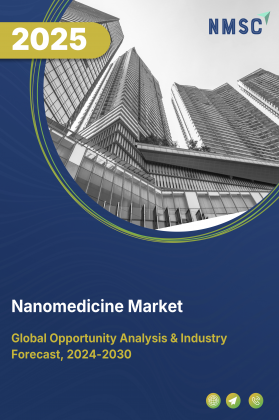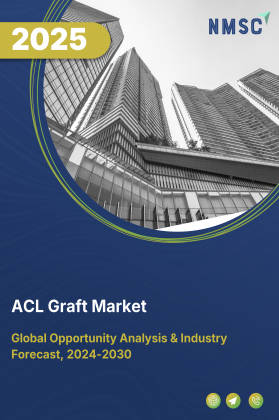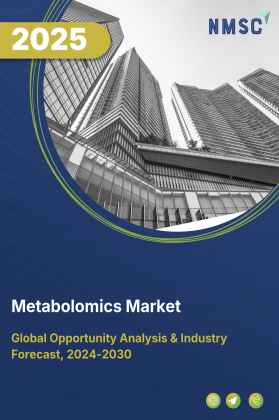
Nanomedicine Market by Product Type (Nanoparticles, Nanodevices, Nanocarriers), by Application (Therapeutics, Diagnostics, Drug Delivery, Imaging, Implants, Others), by Modality (Diagnostics, Therapeutics), by Indication (Oncology, Cardiovascular, Infectious, Neurological, Orthopaedic, Ophthalmological, Immunological, Inflammatory, Others), and by End-User – Global Opportunity Analysis and Industry Forecast, 2025–2030
Industry Overview
The global Nanomedicine Market size was valued at USD 243.79 billion in 2024, and is expected to be valued at USD 270.96 billion by the end of 2025. The industry is projected to grow, hitting USD 459.83 billion by 2030, with a CAGR of 11.9% between 2025 and 2030.
The market is expanding rapidly, driven by advancements in targeted drug delivery, diagnostic applications, and the integration of artificial intelligence. Nanomedicine's ability to enhance drug targeting, improve bioavailability, and enable controlled release is addressing key challenges in conventional therapies, particularly in neurological treatments.
AI is further enhancing the design and functionality of nanomedicines, optimizing drug properties and improving patient outcomes. Despite concerns about safety, toxicity, and regulatory hurdles, nanomedicine offers promising opportunities in personalized medicine, with nanoparticles tailored to individual patient profiles. As precision therapies gain traction, nanomedicine is poised for substantial growth, transforming healthcare with more effective and customized treatments.
Growing Focus on Drug Delivery Through Nanomedicine, Driving Market Growth
The growing focus on targeted drug delivery through nanomedicine is a key driver of the market. Nanomedicine enables precise drug delivery, addressing the limitations of conventional therapies, which suffer from poor specificity, leading to reduced efficacy and adverse side effects.
A 2024 report by the National Institutes of Health (NIH) highlights how nanotechnology enhances drug targeting, improves bioavailability, and enables controlled release, offering more effective therapies with fewer side effects. This advancement is pushing the market forward, creating new opportunities for more efficient and tailored treatments.
Expanding Diagnostic and Therapeutic Applications Fueling Adoption of Nanomedicine
The expanding use of nanomedicine in both diagnostic and therapeutic applications is a key factor driving its global market growth. Its ability to enable targeted drug delivery, early disease detection, and minimally invasive procedures is reshaping modern healthcare.
For instance, a 2024 NCBI study on intranasal drug delivery highlights the advantages of this non-invasive nanomedicine-based approach, reinforcing its potential in improving treatment efficacy and patient compliance.
AI Integration Enhancing Precision Propel Market Expansion
The integration of artificial intelligence is transforming the nanomedicine market growth by enhancing the design, functionality, and deployment of nanotechnologies. According to the National Library of Medicine in 2024, AI is transforming nanomedicine by discovering new nanomaterials and optimizing drug properties, dosages, and treatments, ultimately enhancing efficacy, safety, and minimizing side effects. The growing convergence of AI with nanomedicine is fueling innovation, improving patient outcomes, and driving the market by enabling scalable and data-driven therapeutic solutions.
Safety and Toxicity Concerns Hinders the Growth of the Market
Despite its potential, the nanomedicine market expansion face significant barriers related to safety and biocompatibility. Nanoparticles exhibit unique behaviours in biological systems, forming a "protein corona" that alters their intended action and complicates biodistribution.
Current toxicological testing methods are frequently insufficient to evaluate long-term safety, particularly for complex nano-formulations like bacterial magnetosomes. These concerns hinder regulatory approval and clinical translation, slowing market penetration and requiring more robust safety frameworks to build trust among regulators, clinicians, and patients.
Personalized Medicine Advancements Offers Market Growth Opportunities
Nanomedicine is opening new opportunities in the field of personalized medicine through its ability to deliver customized therapies based on individual patient profiles. Nanoparticles be engineered to carry specific drug molecules or genetic material tailored to a patient’s condition, supporting more effective and safer treatments. When combined with AI-driven biosensors, nanomedicine enables real-time monitoring and precise therapeutic adjustments.
Ongoing clinical trials, such as those exploring nanoparticle-based solutions for multiple sclerosis, highlight the market’s future potential. As the demand for individualized treatment continues to rise, this advancement presents a promising growth avenue for the industry.
Market Segmentation and Scope of the Study
The nanomedicine market report is segmented by product type, application, modality, indication, and end user. On the basis of product type, the market is classified into nanoparticles, nanodevices, and nanocarriers. Based on application, the market is segmented into therapeutics, diagnostics, drug delivery, imaging, implants, and others. By modality, the market is divided into diagnostics and therapeutics. In terms of indication, the market is segmented into oncology, cardiovascular diseases, infectious & anti-infective diseases, neurological disorders, orthopedic & regenerative disorders, urological diseases, ophthalmological diseases, immunological & autoimmune disorders, inflammatory diseases, and others. Based on end user, the market includes hospitals & clinics, research & academic institutes, pharmaceutical & biotechnology companies, diagnostic laboratories, and other
Geographical Analysis
North America, particularly the U.S., remains a leader in the nanomedicine market share, driven by advanced healthcare systems, significant R&D investments, and supportive regulatory frameworks. In September 2024, researchers at the University of Chicago developed a nanomedicine that improves chemotherapy drug penetration in tumors, showcasing continued innovation in the field and further solidifying North America's position as a hub for cutting-edge nanomedicine advancements.
Europe is undergoing significant healthcare system reforms, which are positively impacting the industry. A key initiative, the EU4Health 2024 work programme, has allocated USD 814.39 million to enhance resilience, improve digital health infrastructure, and support community-level diagnostics. These investments are expected to foster innovation in healthcare, including nanomedicine applications, further driving market growth in the region.
Asia-Pacific is experiencing rapid growth in the market, largely driven by the region's aging population. According to the World Health Organization (WHO), the proportion of individuals aged 60 and above in the region is projected to increase significantly, from 12.2% in 2024 to 22.9% by 2050. This demographic shift is expected to amplify the demand for advanced medical solutions, including nanomedicine, to address age-related health issues and improve treatment outcomes.
Latin America, the Middle East, and Africa are emerging in nanomedicine adoption. Brazil and Mexico are increasing investment, with Brazil focused on infectious disease research. Africa, particularly South Africa, is exploring nanomedicine to address unmet medical needs, supported by government initiatives like the South African Nanotechnology Initiative. While infrastructure challenges exist, ongoing R&D and partnerships show strong future potential.
Key Players and Their Strategies in the Global Nanomedicine Industry
Various players in the industry are leading and adopting various strategies. These market players are opting strategies such as business expansions and collaborations to maintain their dominance and competitiveness in the market.
-
In 2024, Nanobiotix is advancing its global NBTXR3 development collaboration within the industry, aiming for long-term growth by preparing to transfer sponsorship of the Phase 3 trial in head and neck cancer, with expectations of positive outcomes.
-
In April 2025, Novartis plans to invest USD 23 billion over the next five years to expand its U.S.-based manufacturing and R&D footprint, with a focus on advancing research and innovative drug delivery systems. This advancement complements the acceleration of the sector.
Key Benefits
-
The report provides quantitative analysis and estimations of the market from 2025 to 2030, which assists in identifying the prevailing industry opportunities.
-
The study comprises a deep dive analysis of the current and future nanomedicine market trends to depict prevalent investment pockets in the sector.
-
Information related to key drivers, restraints, and opportunities and their impact on the industry is provided in the report.
-
Competitive analysis of the players, along with their market share, is provided in the report.
-
SWOT analysis and Porter's Five Forces model are elaborated in the study.
-
Value chain analysis in the market study provides a clear picture of the roles of stakeholders.
Nanomedicine Market Key Segments
By Product Type
-
Nanoparticles
-
Liposomes
-
Polymeric Nanoparticles
-
Metallic Nanoparticles
-
Quantum Dots
-
Dendrimers
-
Micelles
-
Carbon Nanotubes
-
Others (Curadigm Nanoprimer)
-
-
Nanodevices
-
Nano sensors
-
Nanorobots
-
Nano emulsions
-
Others
-
-
Nanocarriers
-
Lipid-Based Nanocarriers
-
Polymer-Based Nanocarriers
-
Protein-Based Nanocarriers
-
Others
-
By Application
-
Therapeutics
-
Diagnostics
-
Drug Delivery
-
Imaging
-
Implants
-
Others
By Modality
-
Diagnostics
-
Imaging
-
Magnetic Resonance Imaging (MRI)
-
Computed Tomography (CT)
-
Positron Emission Tomography (PET)
-
Ultrasound
-
-
Biosensors and Nanoprobes
-
Contrast Agents
-
-
Therapeutics
-
Drug Delivery Systems
-
Gene Therapy
-
Photothermal Therapy
-
Immunotherapy
-
Others
-
By Indication
-
Oncology
-
Cardiovascular Diseases
-
Infectious & Anti-Infective Diseases
-
Neurological Disorders
-
Orthopedic & Regenerative Disorders
-
Urological Diseases
-
Ophthalmological Diseases
-
Immunological & Autoimmune Disorders
-
Inflammatory Diseases
-
Others
By End-User
-
Hospitals & Clinics
-
Research & Academic Institutes
-
Pharmaceutical & Biotechnology Companies
-
Diagnostic Laboratories
-
Others
By Region
-
North America
-
The U.S.
-
Canada
-
Mexico
-
-
Europe
-
The UK
-
Germany
-
France
-
Italy
-
Spain
-
Denmark
-
Netherlands
-
Finland
-
Sweden
-
Norway
-
Russia
-
Rest of Europe
-
-
Asia-Pacific
-
China
-
Japan
-
India
-
South Korea
-
Australia
-
Indonesia
-
Singapore
-
Taiwan
-
Thailand
-
Rest of Asia-Pacific
-
-
RoW
-
Latin America
-
Middle East
-
Africa
-
Key Players
-
Pfizer Inc.
-
Moderna, Inc.
-
Nanobiotix
-
Bristol-Myers Squibb
-
Novartis AG
-
Roche Holding AG
-
Clene Nanomedicine, Inc.
-
QurCan Therapeutics Inc
-
Tecrea Ltd
-
Nanoprobes
-
Nanospectra Biosciences
-
Jazz Pharmaceuticals
-
Cour Pharmaceutical Development
Report Scope and Segmentation
|
Parameters |
Details |
|
Market Size in 2025 |
USD 270.96 Billion |
|
Revenue Forecast in 2030 |
USD 459.83 Billion |
|
Growth Rate |
CAGR of 11.9% from 2025 to 2030 |
|
Analysis Period |
2024–2030 |
|
Base Year Considered |
2024 |
|
Forecast Period |
2025–2030 |
|
Market Size Estimation |
Billion (USD) |
|
Growth Factors |
|
|
Countries Covered |
28 |
|
Companies Profiled |
15 |
|
Market Share |
Available for 10 companies |
|
Customization Scope |
Free customization (equivalent up to 80 working hours of analysts) after purchase. Addition or alteration to country, regional, and segment scope. |
|
Pricing and Purchase Options |
Avail customized purchase options to meet your exact research needs. |

















 Speak to Our Analyst
Speak to Our Analyst

























